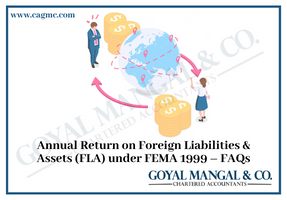 The loan given by non-resident lenders to Indian borrowers who are qualified for the ECB is known as External Commercial Borrowing and can be made in INR or foreign currency. The financing is being used for business purposes. The ECB receives funding from international sources or any reputable organization outside of India. The criteria for obtaining the ECB have been streamlined, and it is now more common because it is generally available on simple terms.
The loan given by non-resident lenders to Indian borrowers who are qualified for the ECB is known as External Commercial Borrowing and can be made in INR or foreign currency. The financing is being used for business purposes. The ECB receives funding from international sources or any reputable organization outside of India. The criteria for obtaining the ECB have been streamlined, and it is now more common because it is generally available on simple terms.
Concept of External Commercial Borrowings
External Commercial Borrowings are commercial loans made by qualifying resident companies to recognize non-resident businesses that must meet certain requirements such as the Minimum Average Maturity Period (MAMP), approved and prohibited end-uses, maximum All-In-Cost (AIC), and so on.
- Obtain Commercial Loans
- Recognized Mortgage Lenders (Non-Resident)
- Qualified Borrowers (Resident)
- For allowed end use and within established parameters (MAMP, AIC)
The Foreign Exchange Management Act, 1999, and the RBI Master Direction- External Commercial Borrowings, Trade Credits, and Structured Obligations control ECBs (FEMA).
Benefits of External Commercial Borrowing
Various benefits of External Commercial Borrowing are:
- Comparatively Low-Interest Rates for Domestic Funds
- Chance to access a Substantial Amount of Money
- The money is accessible for a Fair Period.
- Companies may obtain ECB through sources that are acknowledged globally, such as banks, export credit organizations, cross-border capital exchanges, etc.
- Foreign currencies are one possible form of the ECB. As a result, they give the company access to foreign currency to pay for the import of machinery, among other things.
Various Guidelines regarding External Commercial Borrowing
Various guidelines regarding External Commercial Borrowing are as follows:
- Any Company that is qualified to receive FDI (Foreign Direct Investment) now qualifies as an eligible borrower under the newly reduced eligibility criteria.
- The lender must be from a nation that complies with FATF or IOSCO regulations, including when transferring ECB. If the lender is a person, he or she must own stock in the borrowing company or be authorized to subscribe to bonds or debentures that are listed on an international exchange.
- In addition to INR, ECB is available in any convertible Foreign Currency. When ECB is accessed in foreign currency, it is referred to as ECB denominated in foreign currency.
- When it is accessed in Indian rupees, it is referred to as ECB denominated in INR.
- Three years is the minimum average maturity duration. However, the typical minimum maturity time varies in the following situations:
- The ECB allows for a five-year repayment period for rupee loans used for working capital and general business purposes
- If the ECB is using the funds for working capital, general corporate purposes, or NBFCs lending to other businesses for working capital, the minimum average maturity length is 10 years.
- In cases involving foreign currencies, the ECB has defined the benchmark as a commonly used Alternative Reference Rate of a 6month tenor, suitable to the loan currency.
- Further, any additional fees, such as prepayment penalties or interest rates, should not exceed 2 percent as they fall outside the all-in cost cap.
- The currency of the ECB may change from any foreign currency to Indian rupees, and the exchange rate will depend on whether an agreement for the change was reached between the parties involved or not.
- Under the automated procedure, the maximum amount of ECB that may be raised in a fiscal year is up to USD 750 million.
Non- Availability of ECB
A limited negative list exists for which the ECB is unavailable. The following should be on the list:
- Real estate-related activities
- Investment in the capital markets.
- Investing in a stock.
- Working capital purposes only -ECB raised by foreign equity holders, NBFC financing for working capital or general corporate purposes is the exception.
- On-lending to entities for the aforementioned purposes raised ECB, except NBFCs.
Procedure to obtain Loan Registration Number under ECB
Any ECB loan drawdown should only take place after acquiring the Loan Registration Number (LRN) from the RBI. Borrowers must submit the ECB form, officially signed and confirmed by a professional, along with the ECB agreement and other papers, to obtain the LRN. It is required to submit the ECB form in duplicate. Approaching the designated AD Category I Bank is required by the borrower.
Procedure for raising the ECB
If the requirements provided in this framework are fulfilled, all ECB can be raised automatically. When it comes to the approval process:
- Borrowers may submit an inspection application to the RBI in the required format (Form ECB) via their AD Category I Bank.
- These circumstances will be evaluated in light of the basic principles, the macroeconomic environment, and the merits of the specific proposals.
- ECB suggestions that exceed a particular threshold limit (which may be amended from time to time) submitted to the Reserve Bank will be referred to the RBI’s Empowered Committee.
- The Empowered Committee will include both external and internal members, and in circumstances where the Empowered Committee’s recommendations are implemented, the RBI will make the final decision.
- Entities interested in raising ECB utilizing the automated process should submit a proposal and a completely completed Form ECB to an AD Category I bank.
Limitation and Leverage
Every fiscal year, all qualified debtors are eligible to use the automated process to raise ECB up to USD 750 million or equivalent. Furthermore, the ECB liability-to-equity ratio for ECB raised via the automated technique for FCY-denominated ECB received from direct foreign equity holders cannot be greater than 7:1. This % will not apply if the sum of all outstanding ECB, including the one that is being offered, is less than $5 million or it’s equal.
The ECB’s Reporting
Borrowers must use Form ECB 2 Return to report real ECB transactions to the AD Category I bank on a monthly basis.
Takeaway
ECBs will be used as one of the main vehicles to attract investment to India given that the RBI has established industry-specific differences for the automatic route and the approved route to ECB procurement, as well as end-use limits and minimum average maturity lengths. The Indian GDP is anticipated to remain stable because the RBI now allows ECB earnings to cover loan repayments. At the same time, Indian companies now have broad discretion to seek desperately needed funding from the international market at pleasantly low-interest rates.





